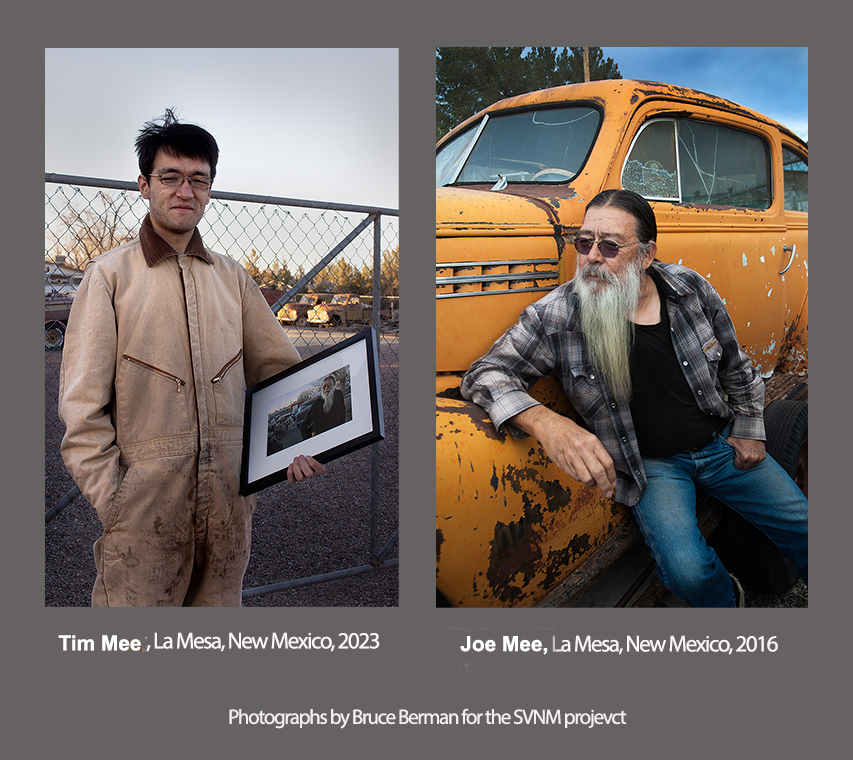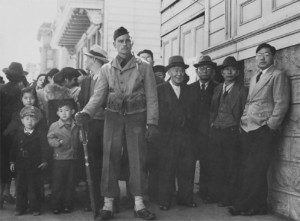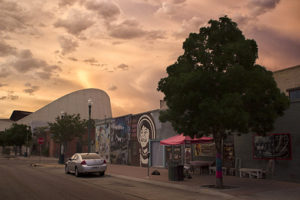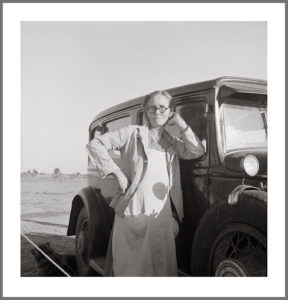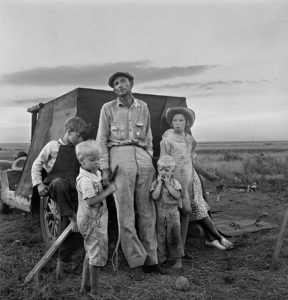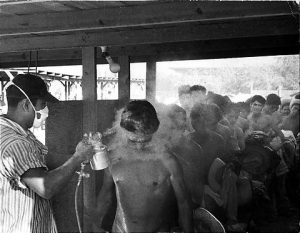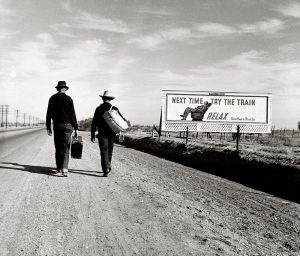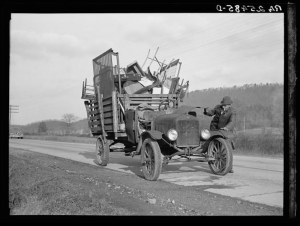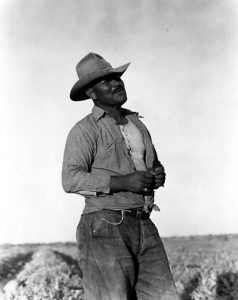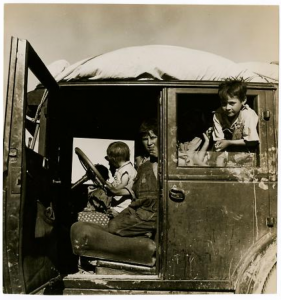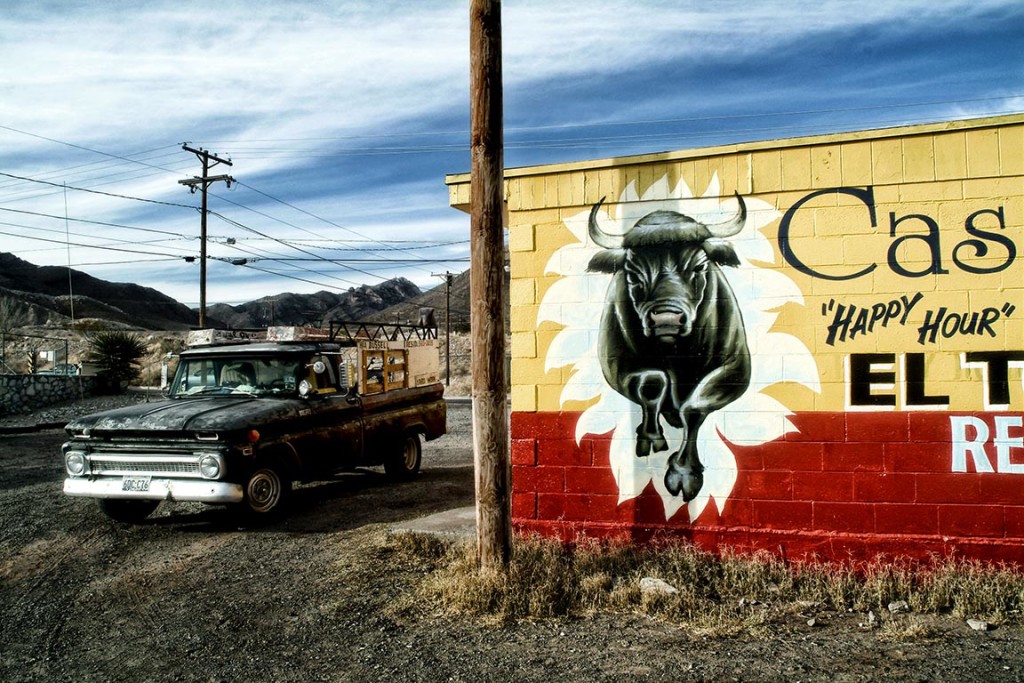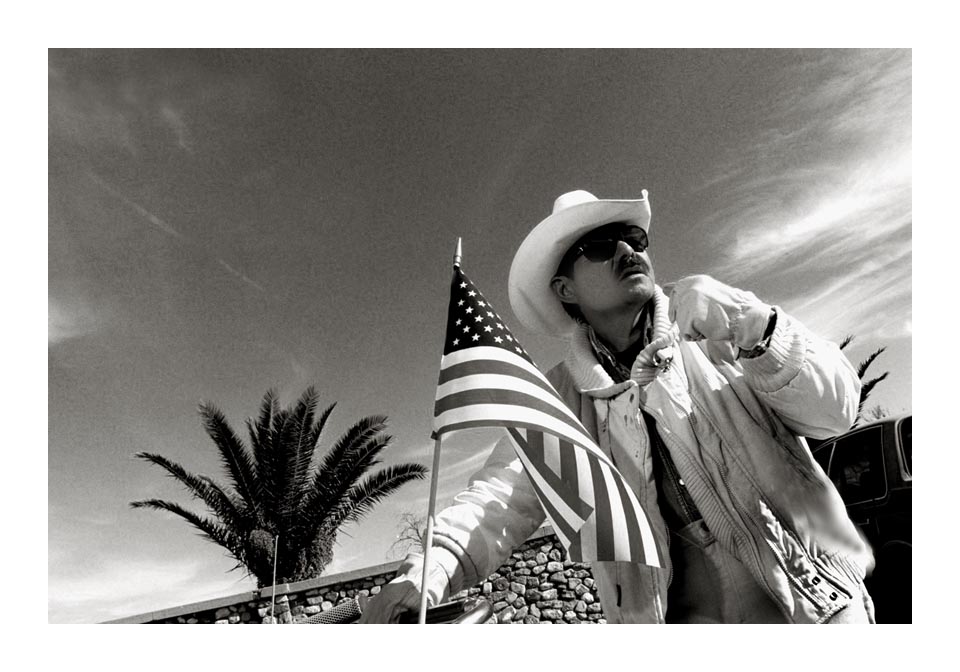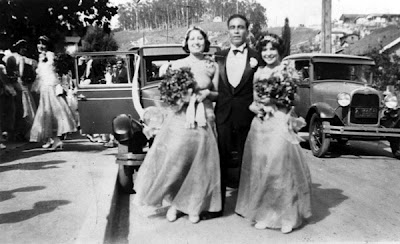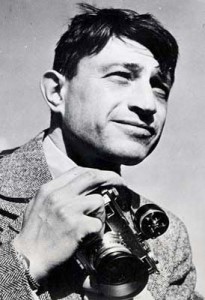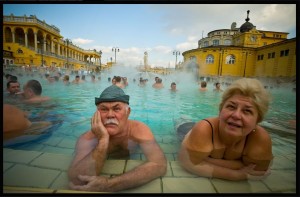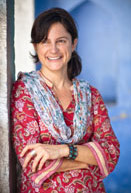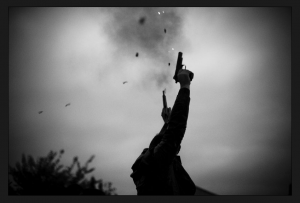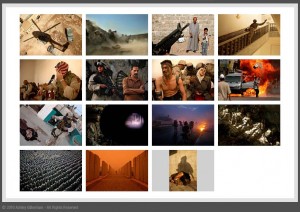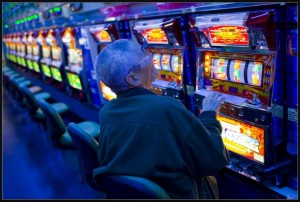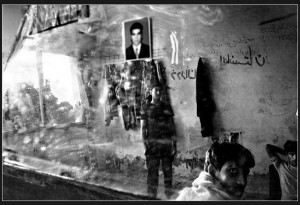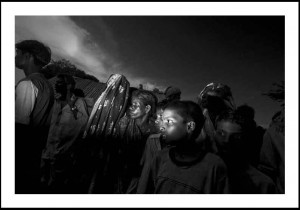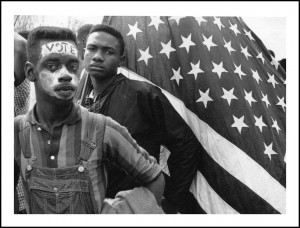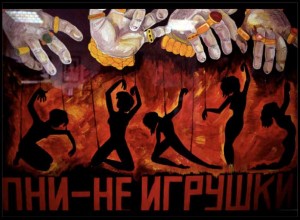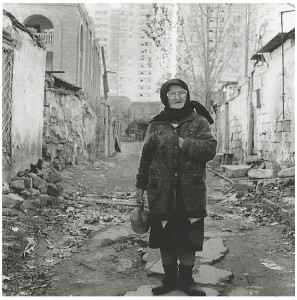Right there, right in La Mesa, New Mexico, four days ago, is the lesson on why we do DOCUMENTARY PHOTOGRAPHY!
My documentary photography class at New Mexico State University (NMSU) has been doing a project for the past twelve years, the Small Village New Mexico project (SVNM), documenting the small villages in southern New Mexico.
One of the students’ favorites towns is La Mesa. Probably because there has been one guy, Joe Mees, who rebuilds cars and Harleys, and has always been very welcoming to the students. It doesn’t hurt that he looks very cool!
Last Thursday, we met Tim Mees, Joe’s son.. He told us of that “Joe has been bed-ridden for about a year.”
DOROTHEA LANGE’S CONFISCATED PHOTOS
Japanese awaiting Internment by Dorothea Lange, 1942
“The photos give a preview of her work commissioned by the federal War Relocation Authority agency in 1942…”
SEE MORE: https://bit.ly/36ZlBQN
DURANGUITO EVENING
GRANDMOTHER ON THE ROAD
MIGRANT FATHER
Migrant Father, June 1938, by Dorothea Lange
Dorothea Lange’s extended caption:
Old time professional migratory laborer camping on the outskirts of Perryton; Texas at opening of wheat harvest. With his wife and growing family; he has been on the road since marriage; thirteen years ago. Migrations include ranch land in Texas; cotton and wheat in Texas; cotton and timber in New Mexico; peas and potatoes in Idaho; wheat in Colorado; hops and apples in Yakima Valley; Washington; cotton in Arizona. He wants to buy a little place in Idaho
WELCOME TO AMERICA AND ALL THAT GAS
Photo by Leonard Nadel
Editor’s Note: The Bracero program addressed the issue of demand for labor and the need for work. It was a cooperative program that allowed America’s work needs to utilize the need of Mexico’s workers’ need for employment. It was legal, it was effective and it was a clear win-win program. Therefore it did not last. Too logical. And here we are now, 52 years later, with America needing workers, Mexicans needing employment and total chaos at the border. One could ask, is this chaos or planned exploitation?
Here is a mini-history of the Bracero Program. Let the discussion begin.
Text by Smithsonian National Museum of American History The Bracero program (1942 through 1964) allowed Mexican nationals to take temporary agricultural work in the United States. Over the program’s 22-year life, more than 4.5 million Mexican nationals were legally contracted for work in the United States (some individuals returned several times on different contracts). Mexican peasants, desperate for cash work, were willing to take jobs at wages scorned by most Americans. The Braceros’ presence had a significant effect on the business of farming and the culture of the United States. The Bracero program fed the circular migration patterns of Mexicans into the U.S.
Several groups concerned over the exploitation of Bracero workers tried to repeal the program. The Fund for the Republic supported Ernesto Galarza’s documentation of the social costs of the Bracero program. Unhappy with the lackluster public response to his report, Strangers in Our Fields, the fund hired magazine photographer Leonard Nadel to produce a glossy picture-story exposé.
Presented here is a selection of Nadel’s photographs of Bracero workers taken in 1956: shttp://s.si.edu/1gRD3VJ for Nadel’s photographs and other resources.
LANGE AND HER TRANSCRIBED TEXT
PEOPLE ON THE MOVE: 1937
Tenant farmer moving his household goods to a new farm.
Hamilton County, Tennessee, Rothstein, Arthur, 1937 (LOC)
IMPERIAL VALLEY, 1935
MIGRATION 30s STYLE
Ten Children, March 1937, by Dorothea Lange,
for the RA (courtesy of OMCA)
PRE ART LANDSCAPE
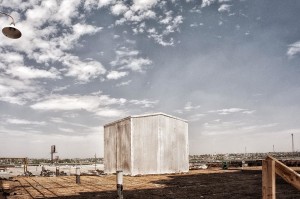
The Pre Art Landscape is one in which there are images only attractive to some’s intellect that titillates the intellect of others who are over educated, over intellectualized, clean from lack of experience with the world that they choose to not touch and where, through their lack of desire to know a world around them other than the one aforementioned, allows them to revere and praise that which is without interest to anyone but them and their ilk.
So here is an image from my Guggenheim Fellowship submission. I created this less than fifteen minutes ago by walking out the back door of my slum loft (yes there are still some around that the yuppies and Julias haven’t occupied and, therefore, chased out those who were living there, not for some feeble concept of what is cool, but because, previously, they could afford the rent if they were willing to put up with the inconveniences and degradations of everything that the word “slum” implies).
If I hadn’t written this piece I very well may have earned a Guggenheim.
I coulda been a contenda…instead of -let’s face it- a bum…which is a what I am…*
I couldn’t resist the rant.
I suspect that’s what has saved my heart’s soul from an early death.
*Thank you Budd Schullberg (http://bit.ly/1KetpPl)
BRIDGE TO SOMEWHERE
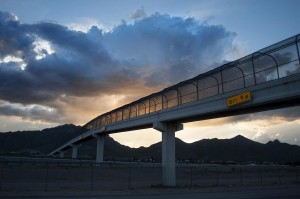
Text and Words by Bruce Berman
The meteorologists call this a “High Pressure system being pushed out by a Low Pressure system.”
Photographers will admit “every once in a while things come together and you get a lucky.”
What do I call it? What does one get for being out there, every evening and every day, always with your “axe (camera)at the ready, often coming home with nothing but the pleasure of having been out there trying?”
The funny thing is, as usual, I was in a part for town I’d never been in before (there are few left). It is a very unusual ‘hood for El Paso. In another city one would call it the “ghetto.” Here, no one thinks there is a ghetto. Being a predominantly latino city (82%), if you have a neighborhood that is lower income, the natural thing is to call it a barrio. This neighborhood was definitely “low income,” and of the three people I conversed with, two had been drinking alcohol to the point of inebriation. It is a mostly Black neighborhood, unusual in El Paso that is only 4% African-American.
HAPPY HOUR EL PASO
Text and photograph by Bruce Berman
El Paso is in transition. It was always complicated. There was the whole “Southwest” thing and then again, there was the whole Chicanismo thing, and then again there was the cowboy thing, and then again there was a certain ex Pat vibe for 60s and 70s refugees who never went home.
And there was the growing suburban thing, the Ohio is too cold and El Paso is affordable tilt.
Viva complication!
Now El Paso is getting more simple. It is trying to spruce itself up and become a destination. They have a baseball team downtown now, and a restored fancy movie theater within walking distance of it and there are bicycle riders and bicycle lanes everywhere ( a sure sign that the “texture days” are done).
It’s still El Paso but some (real estate developers and those that are young that can’t quite make it out) hunger for it to be Cincinnati. Good luck.
For those who have known El Paso for many decades, to see court jester-dressed bicyclists pedaling through downtown is jarring. It is a pure contrast to the bruised authenticity that has been El Paso’s greatest strength (for me), for those of us who have been hiding here.
Street Guys and Old Glory
Kimball the American, El Paso, Texas, by Bruce Berman
Commentary by Bruce Berman, Editor
Why is it the street guys not only aren’t shy about flying “Old Glory,” but are vigorous in telling you why they love it? Compare this to any college campus. Not only can you not find a glimpse of the Stars and Stripes, there are numerous organizations that want it -or anything it represents….like the military- anywhere near it.
Is a puzzlement or is it an insight?
Perhaps, as we look at the condition of the country and the rumors of its demise, we need to start looking to the streets for some answers, not to the walls of academe.
Viva Kimball.
Susan Meiselas on The Engaged Photographer
Editor’s note: Susan Meiselas, Magnum Photographer and long time great documentarian, discusses documentary photography, motivations, uses, intentions and hopes for the work’s impact on subjects and society.
This project, funded by the Open Society Foundations (Meiselas Co-Curated the project’s exhibition), shows the work of some of the world’s best contemporary photographers working in this discipline.
Chavez Ravine Back In The Day
Bridesmaids and best man at a wedding in Chavez Ravine, 1929.
Courtesy of the Shades of L.A. Collection, Los Angeles Public Library
The “Story Teller With Pictures”: Carl Mydans
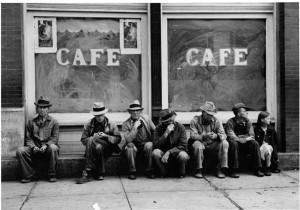
Article edited and written by Bruce Berman
Carl Mydans began his photographic career with the Farm Security Administration in 1935, and was quickly hired away by Life magazine in 1936. Mydans photographed national stories until 1939, when Life sent Carl and his wife Shelley Smith Mydans to cover the war in Europe as the first husband and wife photo-journalist team.
From Europe, the couple was re-assigned to the Pacific theater. In 1941 they were captured by Japanese forces in the Philippines and held as prisoners of war until 1943. Mydans returned to the war alone in 1944 to cover the Italian front, while his wife and partner remained behind in the United States.
Carl Mydans was born in Boston on May 20, 1907. The family moved to Medford, Massachusetts, on the Mystic River where Carl went to high school and worked in the local boatyards after school and on weekends. He later became interested in journalism and worked as a free-lance reporter for several local newspapers. In 1930 he graduated from the Boston University School of Journalism.
Mydans then moved to New York and, while working as a reporter for the “American Banker,” began to study photography at the Brooklyn Institute of Arts and Sciences. In July 1935 his skill with the new 35mm “miniature” camera landed him a job with the Department of the Interior’s Resettlement Administration, which soon merged into the Farm Security Administration (FSA). Mydans joined Walker Evans and Arthur Rothstein as the core of the remarkable team of photographers assembled by Roy Stryker to document rural America.
While travelling through the southern states photographing everything that had to do with cotton, Mydans developed the shooting style he would use throughout his career. He concentrated on people, and he photographed them in a respectful and straightforward manner. As he had been taught to do as a reporter, he kept careful notes on every shot.
When Mydans joined the staff of Life in 1936 he joined a group of photojournalists who were changing the way press photography was done. Photojournalists had traditionally used 4×5 Speed Graphic cameras with flashguns and reflector pans, and their pictures of people tended to look much the same: overlit foregrounds fell off to dark backdrops that had no detail. But Mydans and his colleagues at Life relied on 35mm cameras that allowed them to work with available light, capturing a new kind of excitement and activity in their photographs. Their success with the small camera revolutionized the practice of photojournalism.
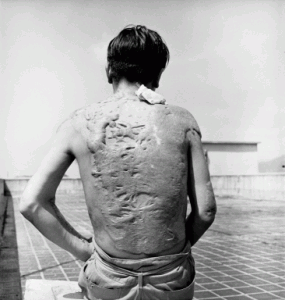
Altaf Qadri
Altaf Qadri, 35, is an award winning photographer.
Qadri, 35, won a World Press Photo award this year for his poignant photograph of relatives mourning over the body of a man killed in a shooting by Indian police in Indian-controlled Kashmir.
photography Altaf Qadri
Qadri, an Indian citizen, is a native of the Kashmiri city of Srinagar. He studied science at Kashmir University and worked as a computer engineer before taking a job as a staff photographer at a local Kashmiri newspaper in 2001.
CLICK ON THIS IMAGE FOR MORE Altaf Qadri: 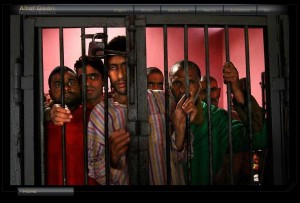
In 2003, he joined the European Press Photo Agency and covered the conflict in Kashmir. In 2008, he began working for The Associated Press in the Indian city of Amritsar. His work has appeared in magazines and newspapers around the world and has been exhibited in the United States, China, France and India.
Bruce Berman Shoots Juárez
[flagallery gid=1 name=”Gallery”]
El Paso —-
Bruce shoots Juárez. Reluctantly and with remorse.
Since 2008 the photographer has been documenting the aftermath of violence in the troubled northern Mexico city. His interest is in the effect of the Cartel War on the population of the city, particularly the effect on the children of the city who have grown up knowing little else.
His current work is in a mental institution in the city, what he refers to as “The House Of The Abandoned.”.
The body of work -The Other Truth- will appear on this site on November 18th.
Ami Vitale; Beauty, Power, Life
Hungary Baths by Amy Vitale©2011
From Ami Vitale’s website (http://www.amivitale.com):
Ami Vitale’s journey as a photojournalist has taken her to more than 75 countries. She has witnessed civil unrest, poverty, destruction of life, and unspeakable violence. But she has also experienced surreal beauty and the enduring power of the human spirit, and she is committed to highlighting the surprising and subtle similarities between cultures. Her photographs have been
exhibited around the world in museums and galleries and published in international magazines including National Geographic, Adventure, Geo, Newsweek, Time, Smithsonian. Her work has garnered multiple awards from prestigious organizations including World Press Photos, the Lowell Thomas Award for Travel Journalism, Lucie awards, the Daniel Pearl Award for Outstanding Reporting, and the Magazine Photographer of the Year award, among many others.
Now based in Montana, Vitale is a contract photographer with National Geographic magazine and frequently gives workshops throughout the Americas, Europe and Asia. She is also making a documentary film on migration in Bangladesh and writing a book about the stories behind the images.
Andrea Bruce Shoots You In The Heart
Ingushetia by Andrea Bruce
Andrea Bruce is a passionate, stylish, skilled documentary photography who’s images -in the best traditions of still photography- sear your soul and drive their point through your heart, restoring it instead of terminating it. She is the new breed of documentary photographer that blends all the skills of good journalism with all the skills of great graphic image-making and produces a coctail that is nothing less than photo alchemy.
Take a look: http://www.andreabruce.com
Ashley Gilbertson: Shrines and Conflicts
Contact Sheet of Ashley Gilbertson’s Conflict Photography
“He has a very good news sense and for me that’s really essential,”
says Cecilia Bohan, foreign picture editor for The New York Times.
“I need them [her photographers] to be my eyes and ears on the ground.”
Ashley Gilbertson is a VII photographer and one of the strongest Conflict Photographers working today. His recent work, done far from the battlefield but in the bedrooms of fallen soldiers, is one of the strongest testaments to the outright sadness about Loss that War induces, that this editor has ever seen.
For a sample of Mr. Gilbertson’s work:
- For a personal website:SEE: http://www.ashleygilbertson.com/index.php
- A piece from 2004 in Photo District News, SEE: http://www.ashleygilbertson.com/index.php
- For The Shrine Down The Hall, SEE: http://www.nytimes.com/interactive/2010/03/21/magazine/20100321-soliders-bedrooms-slideshow.html?hp
End of Labor Town: Dumping Ground of Old Men in Japan
These are not the view of Japan that we normally see. Shiho Fukada shows us how some elderly people in Japan fare. It is not a story unique to Japan.
SEE http://www.socialdocumentary.net/exhibit/shiho_fukada/728
Moises Saman: Lost Boys of Afghanistan
Lost Boys of Afghanistan by Moises Saman
See this stirring slideshow by Moises Saman shot for The New York Times: http://www.nytimes.com/slideshow/2009/08/27/world/20090827AFGHANMINORS_index.html
Dhiraj Singh: The (New) Eyes Of India
From “Six Feet Under,” ©2009Dhiraj Singh
For more work by Dhiraj Singh, SEE: http://www.dhirajsingh.com/01.htm
Dhiraj Singh is a Photojournalist who lives in Mumbai, India. His work has been published in numerous international magazines and online journals, including Newsweek, Vanity Fair, msnbc.com, The Wall Street Journal, L’Expresso, and, many others. He has won numerous awards (see his “bio,” on his site, above) and participated in many exhibitions. His pictures of the Mumbai terror attacks in 2008 were part of the prestigious group exhibition titled, ‘Bearing Witness’ held in Mumbai in 2009.
Documentaryshooters is honored to have permission to publish Mr. Singh’s work. We feel he has the insights and skills to show India as it is, depicting its greatness and its struggles, its deep and ancient soul as well as its modern and energetic heart. He, as no other photographer has, since, the great Raghu Rai’s seminal work of the 1970’s, ’80’s and 90’s, not only shows India and the sub continent, he makes us feel it.
Parikarma: But It Rained
Parikrama: But It Rained from Split Magazine on Vimeo.
This is a rock band video based on a magazine article about kidnap victims in Kashmir and those who wait for their return. This is one of India’s most revered bands and was one of India’s all time most popular rock songs.
Vote
“Vote,” Selma Voting Rights March, 1965
©Bruce Davidson
Sometimes we forget that the “Big Work,” the work that one becomes known for making isn’t all there is.
Bruce Davidson went south, from Chicago, on instinct.
The world was shaking and he felt the vibe.
The time was now: Civil Rights.
Real change.
Without assignment or specific destination he “nailed it,” and was able to work on the edges of the news, tell the story from a personal and deeply intimate viewpoint.
This image, for me, is one his best. Beautiful composition. Beatiful moment. Beautiful storyline. Iconic and packed with all the elements that make it a novel unto itself, if this was the only photography that existed from the era it was shot in, it would, I think, be enough to tell the story of the struggle.
One word and one image: sometimes it’s enough: Vote.
For More on Bruce Davidson: http://en.wikipedia.org/wiki/Bruce_Davidson_(photographer)
Prostitution: Pain
©2009 Photograph by Mimi Chakarova
GO TO: http://www.mclight.com/slideshow.html
Editor’s Note
This is one of the most painful documentaries I have ever seen.
Even more amazing is the fact that the work is not the slam and splash type of photojournalism that deals in blood, guts and flames.
Azerbaijan: Displacement Ex-Soviet Style
©Rena Effendi
GO TO: http://www.fiftycrows.org/index.php#s=0&p=0&a=2&mi=2&pt=1&pi=10000&at=1
Displacement. A world wide problem. When the Grid comes you got to move no matter that there is no good place to go to from the bad place you have become accustomed to. It looks the same in Azerbaijan, Mexico DF, Lomas del Poleo, Chicago…wherever.
Rena Effendi takes us into the rarely seen inner Azerbajian, to the mahalla neighborhood in the capitol city of Baku.

